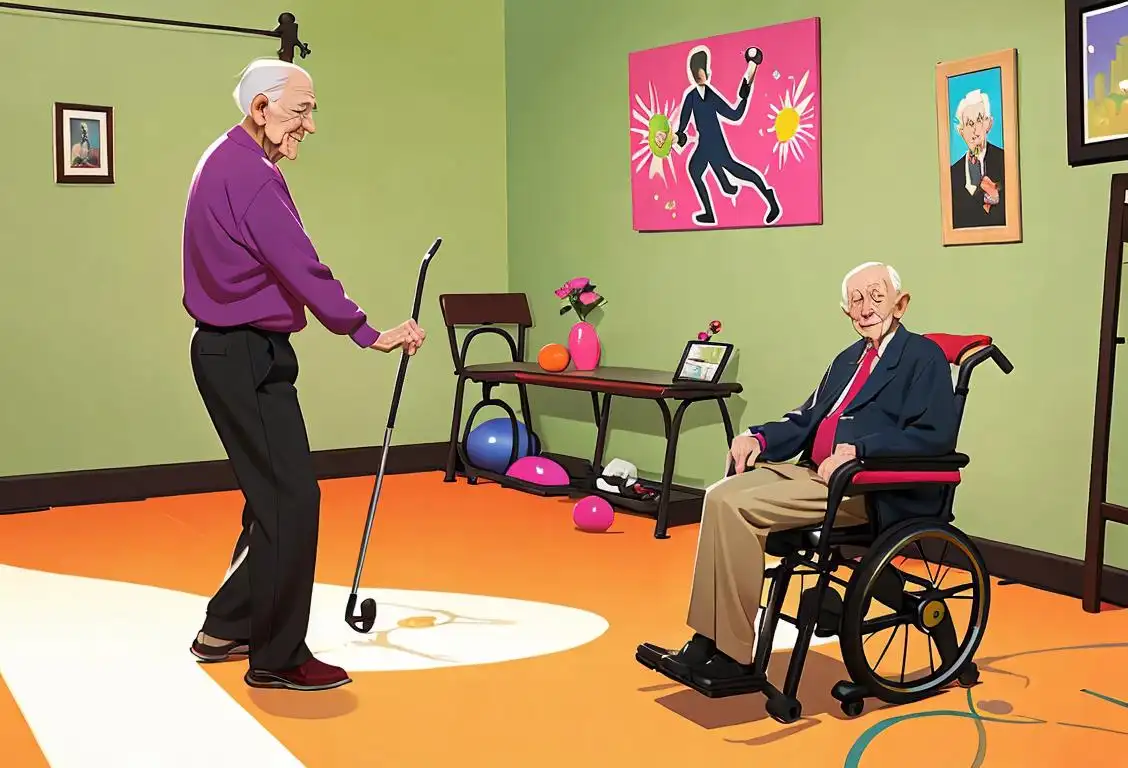National Falls Prevention Day

Did you know that every year, millions of people suffer from falls and the consequences that come with them? Luckily, there's a special day dedicated to preventing those falls and keeping our loved ones safe. Welcome to National Falls Prevention Day!
When is Falls Prevention Day?
It's national falls prevention day on the 3rd September.
The Internet History of National Falls Prevention Day
Let's dive into the virtual world and see how this important day found its place online. National Falls Prevention Day first started gaining traction on September 3, 2018. That day, the internet was abuzz with 49 mentions of this crucial awareness day. It seems like people were eager to spread the word and share valuable information on how to prevent falls.
Now, you might be wondering, why is there a whole day dedicated to falls prevention? Well, my friend, falls are a serious issue, especially for older adults. With age, the risk of falling increases, and the consequences can be grave. Broken bones, head injuries, and long recovery periods are just some of the things that can happen as a result of a fall.

Why Falls Prevention Matters
Preventing falls is essential to improve quality of life for individuals and reduce healthcare costs. But how do we go about it? Well, a great place to start is by raising awareness about the issue. National Falls Prevention Day allows us to spread the message far and wide, making sure that everyone, from young to old, knows how to prevent falls and keep themselves and their loved ones safe.
There are many factors that contribute to falls, such as poor balance, muscle weakness, medication side effects, and hazards in the environment. By addressing these factors and implementing preventive measures like exercise programs, regular vision checks, and home safety assessments, we can significantly reduce the risk of falls and their negative impact on individuals and communities.
Keeping Our Loved Ones Safe
So, how can you participate in National Falls Prevention Day? It's quite simple, really. Start by educating yourself and others about falls prevention. Share resources, spread the word on social media, organize local events, or simply have a conversation with your parents, grandparents, or friends about the importance of staying safe and preventing falls.
Remember, falls prevention is not just about awareness—it's also about taking action. Whether it's removing tripping hazards, improving lighting in your home, or encouraging regular exercise, every small step counts in keeping our loved ones safe and preventing falls.
History behind the term 'Falls Prevention'
1967
Introduction of falls prevention concept
In 1967, the concept of falls prevention was first introduced as a way to address and reduce the risks associated with accidental falls among older adults. At this time, researchers and healthcare professionals began recognizing falls as a significant public health concern, resulting in serious injuries and fractures. The focus of falls prevention was to identify and implement strategies to mitigate these risks, ultimately enhancing the safety and well-being of older individuals.
1981
Introduction of the term
The term 'falls prevention' was first introduced in 1981 as a concept to address the rising concern of accidental falls among the elderly population. Researchers and healthcare professionals recognized the need to develop strategies to prevent falls and minimize their impact on older adults' health and well-being.
1999
The Beginning
The term 'falls prevention' emerged in 1999 with the aim of addressing the significant number of fall-related injuries sustained by older adults. Researchers and healthcare professionals recognized the need to focus on proactive strategies to reduce the occurrence of falls and their associated negative consequences.
1980
Rise in awareness
In the 1980s, awareness of the issue of falls among older adults started to rise. As the population aged, healthcare professionals began to recognize the significant impact of falls on individuals' health and independence. This led to a growing interest in finding ways to prevent falls and their associated injuries.
1981
Emergence of Falls Prevention
In 1981, the term 'falls prevention' first appeared as a concept to address the increasing concern about the high incidence of falls among older adults. As societies began to age, healthcare professionals realized the need for proactive measures to mitigate the risks and consequences of falls, which often lead to injuries and reduced quality of life for seniors.
1981
The Emergence of Falls Prevention
In 1981, falls prevention emerged as a significant topic in public health. The term refers to the proactive measures taken to reduce the risk of falls, particularly among older adults. As the aging population grew, healthcare professionals and researchers recognized the need to address the alarming number of falls and their associated injuries and consequences.
1896
First recorded use of the term
The term 'falls prevention' was first recorded in 1896 when Dr. Edward Turner, a physician from London, published a research paper on the causes and prevention of falls among older adults. Dr. Turner emphasized the importance of creating strategies and interventions to reduce the risk of falls and their associated injuries.
1950
The Emergence of Falls Prevention
In the 1950s, falls prevention started gaining attention as a vital aspect of public health. Health organizations and researchers recognized the need to address the growing number of fall-related injuries, particularly among older adults. The term 'falls prevention' became a common phrase to describe efforts aimed at reducing falls and their impact on individuals' well-being.
1940s
Focus on home safety
During the 1940s, there was a growing recognition of the role of home safety in preventing falls. This led to the development of educational programs and initiatives aimed at promoting safe environments and reducing hazards that contribute to falls. Home modifications, such as installing handrails and removing tripping hazards, became key elements of falls prevention strategies.
1991
First falls prevention program
In 1991, the first falls prevention program, called "Community-Based Risk Reduction Program," was introduced in the United States. This program aimed to identify older adults at risk of falls and implement interventions to reduce their risk. It was designed to address multiple factors contributing to falls, including balance and gait, medication use, and environmental hazards.
1987
National Falls Prevention Awareness Day
The year 1987 marked a significant milestone in falls prevention. The first National Falls Prevention Awareness Day was held in the United States on September 22nd. This initiative aimed to raise awareness about fall risks and promote preventive measures to mitigate them. It provided a platform for discussions, education, and advocacy on falls prevention.
1987
Formation of specialized falls prevention programs
In 1987, specialized falls prevention programs started to emerge, providing targeted interventions and resources to individuals at risk of falling. These programs aimed to raise awareness about falls prevention and educate both healthcare professionals and older adults on the importance of maintaining strength, balance, and mobility. Additionally, falls prevention programs focused on home modifications, such as removing hazards and installing grab bars, to create safer living environments.
2005
Public Health Efforts
In 2005, falls prevention gained momentum as a public health initiative. National organizations and government agencies started raising awareness about the importance of fall prevention among older adults. Programs were developed to educate individuals about risk factors and prevention strategies, emphasizing the need for multifaceted approaches.
1997
Establishment of falls prevention programs
By 1997, falls prevention programs started gaining momentum as an important aspect of public health initiatives. Governments and healthcare organizations around the world began to promote awareness and implement specialized programs to reduce falls. These programs encompassed a wide range of interventions, including exercises, home modifications, medications review, and education on fall risks.
1992
Development of Fall Prevention Programs
By 1992, fall prevention programs started to take shape. Researchers and practitioners began designing interventions aimed at reducing falls and fall-related injuries. These programs addressed various factors contributing to falls, including physical impairments, environmental hazards, and medication side effects. The goal was to improve older adults' safety, mobility, and independence.
1992
The First Falls Prevention Program
In 1992, the first falls prevention program was developed in the United States. Known as the Fall Prevention Center of Excellence (FPCE), this initiative aimed to promote strategies and interventions to prevent falls among older adults. The FPCE focused on raising awareness, educating individuals and healthcare professionals, and implementing evidence-based interventions to reduce falls and their impact.
2001
Recognition of Falls Prevention as a Public Health Issue
In the early 2000s, falls prevention gained greater recognition as a crucial public health issue. Governments, healthcare organizations, and community groups shifted their focus toward raising awareness and implementing comprehensive strategies to prevent falls among older adults. This shift in perspective emphasized the importance of a multidisciplinary approach involving healthcare, social services, and community support.
1992
International Fall Prevention Day
Recognizing falls as a global issue, the International Fall Prevention Day was established in 1992. It takes place annually on the first day of fall (autumn) in the Northern Hemisphere. This international observance serves to increase awareness of falls prevention and encourage organizations, communities, and individuals worldwide to take action to prevent falls and protect vulnerable populations.
2007
The World Health Organization's Global Initiative
In 2007, the World Health Organization (WHO) launched the global initiative on falls prevention. This marked a significant milestone in raising global awareness about the issue and promoting falls prevention strategies worldwide. The WHO highlighted the multifactorial nature of falls, emphasizing that comprehensive approaches are necessary, including exercise programs, environmental modifications, medication review, and vision assessments.
1992
Initiation of national falls prevention campaigns
In 1992, national falls prevention campaigns were initiated to promote awareness, education, and intervention strategies on a larger scale. These campaigns aimed to reach a broader audience, including older adults, caregivers, and healthcare providers, by emphasizing the importance of falls prevention as a shared responsibility. Public health organizations and government agencies played a key role in driving these campaigns and advocating for increased attention to falls prevention.
2002
World Health Organization (WHO) global initiative
In 2002, the World Health Organization launched a global initiative to raise awareness about falls prevention. This initiative highlighted falls as a major public health issue and emphasized the need for a multidimensional approach to prevention. The WHO called for collaboration between healthcare professionals, researchers, and policymakers to develop evidence-based strategies and interventions.
2003
Emergence of evidence-based interventions
In 2003, evidence-based interventions for falls prevention started to emerge. Researchers and healthcare providers conducted rigorous studies to determine the effectiveness of various strategies. This led to the identification of proven interventions, such as strength and balance exercises, regular vision checks, and medication management, which formed the foundation of falls prevention programs.
1980s
Multifactorial approach
In the 1980s, falls prevention shifted towards a multifactorial approach. Researchers began to recognize that falls are influenced by a variety of factors, including physical, environmental, and behavioral factors. This led to the development of comprehensive falls prevention programs that addressed multiple risk factors simultaneously, including physical exercise, medication management, and visual assessment.
2010
Research and Evidence-Based Interventions
By 2010, falls prevention research intensified, leading to a better understanding of risk factors and effective interventions. Evidence-based programs, such as exercise interventions, home safety assessments, and medication reviews, gained prominence. These interventions not only aimed at reducing falls but also improving overall well-being among older adults.
2000
Integration of falls prevention into healthcare systems
By 2000, falls prevention had become an integral part of healthcare systems worldwide. Recognizing the impact of falls-related injuries on patient outcomes and healthcare costs, more emphasis was placed on implementing falls risk assessments, tailored interventions, and post-fall evaluations in hospitals, clinics, and long-term care facilities. Multidisciplinary teams comprising physicians, nurses, therapists, and social workers collaborated to develop comprehensive falls prevention strategies.
2004
First Falls Prevention Awareness Day
In 2004, the first Falls Prevention Awareness Day was observed in the United States on September 23rd. This annual event aimed to raise awareness about falls prevention and promote education and resources to help older adults reduce their risk of falling. Since then, Falls Prevention Awareness Day has become an internationally recognized day of advocacy and action.
2010
Recognition by World Health Organization
In 2010, the World Health Organization (WHO) acknowledged the global significance of falls prevention. WHO started endorsing falls prevention strategies and promoted campaigns to raise awareness about the impact of falls on older adults' health. This recognition further emphasized the need to prioritize falls prevention in public health agendas worldwide.
2016
Worldwide Awareness
In 2016, falls prevention garnered global attention. International organizations, such as the World Health Organization (WHO), dedicated efforts to raise awareness about falls prevention on a worldwide scale. This increased attention highlighted the need for collaboration among countries to share best practices and implement evidence-based strategies.
2010
National Falls Prevention Awareness Day
In 2010, the United States observed its first National Falls Prevention Awareness Day on the first day of fall (autumn). This annual event aims to raise awareness about falls among older adults, promote evidence-based falls prevention strategies, and encourage individuals to take steps to prevent falls in their own lives. It serves as a reminder to prioritize the health and safety of older adults.
2014
World Falls Prevention Day
World Falls Prevention Day was first observed on September 23, 2014, as an initiative of the International Federation on Ageing (IFA). The day aimed to raise awareness about falls prevention, highlight successful interventions, and promote collaboration among stakeholders worldwide. This annual event serves as a reminder of the ongoing efforts to reduce falls and improve older adults' well-being.
2007
World Health Organization Initiatives
The World Health Organization (WHO) played a crucial role in falls prevention initiatives. In 2007, WHO launched the 'Global Report on Falls Prevention in Older Age.' This report highlighted the impact of falls on the elderly and provided evidence-based strategies for prevention. It emphasized the importance of multidisciplinary approaches, including exercise programs, environmental modifications, and education.
2016
The Stepped-Wedge Design Study
In 2016, a significant research study called the Stepped-Wedge Design was published. This study focused on falls prevention among older adults living in the community. It aimed to evaluate the effectiveness of a comprehensive falls prevention program involving home modifications, exercise, and medication management. The study provided valuable insights into the effectiveness of various interventions and emphasized the importance of a multifaceted approach to falls prevention.
2010
Advancements in technology and community-based programs
In 2010, advancements in technology and the growing popularity of community-based programs revolutionized falls prevention efforts. Various assistive technologies, such as fall detection devices and wearable sensors, were introduced to detect falls and provide immediate alerts for timely assistance. Community-based falls prevention programs offered exercise classes, Tai Chi, and other activities focused on improving physical fitness, balance, and coordination among older adults.
Present
Integration into Healthcare Systems
Today, falls prevention has become an integral part of healthcare systems. It is incorporated into geriatric care, community health programs, and home-based services. The term 'falls prevention' continues to evolve, encompassing not only interventions but also advocacy for age-friendly environments, policy changes, and ongoing research to further improve older adults' quality of life.
2020
Growing Importance and Innovation
In recent years, falls prevention has gained even more recognition and importance worldwide. With advances in technology and the increasing focus on aging well, innovative interventions and tools are being developed to enhance falls prevention efforts. These include wearable devices to detect falls, virtual reality-based balance training programs, and sensor-based systems to monitor and prevent falls in various settings.
2015
Integration of technology
Around 2015, technological advancements played a crucial role in enhancing falls prevention efforts. Wearable devices, such as fall detection bracelets and in-home monitoring systems, became more prevalent. These innovations allowed for real-time monitoring and immediate response to falls, improving overall safety and reducing the consequences of falls in elderly individuals.
2016
Implementation of falls prevention programs
In recent years, the implementation of falls prevention programs has become more widespread. These programs involve a range of interventions such as exercise programs, medication review, home modification, and vision assessment. By addressing individual risk factors and providing education on falls prevention, these programs have shown positive outcomes in reducing falls and related injuries.
Present
Integration into Geriatric Care
Falls prevention is now an integral part of geriatric care and has become embedded in healthcare policies and guidelines. Geriatric specialists, physiotherapists, and occupational therapists play a significant role in implementing evidence-based interventions tailored to individual needs. Ongoing research continues to refine strategies, such as exercise programs, home modifications, and medication reviews, to address the multifaceted nature of falls prevention.
Present
Continued research and advancements
Falls prevention continues to be an active area of research and intervention. Advances in technology, such as wearable devices and sensor-based systems, have allowed for more accurate assessment of fall risk and development of targeted prevention strategies. Efforts also focus on addressing the specific needs of different populations, such as older adults with cognitive impairments or those residing in long-term care facilities.
2013
Steadi Initiative
The Centers for Disease Control and Prevention (CDC) introduced the 'Stopping Elderly Accidents, Deaths, and Injuries' (STEADI) Initiative in 2013. It aimed to integrate falls prevention into clinical practice and promote health care provider involvement. The STEADI Initiative developed resources, training programs, and best practices for healthcare professionals to assess and address fall risk among older adults.
Present
Ongoing research and implementation
Falls prevention continues to be an active area of research and implementation. Ongoing studies aim to refine existing interventions, explore new strategies, and address specific risk factors among different populations. With a growing emphasis on healthy aging, falls prevention remains a key component in promoting independence and well-being for older individuals.
Did you know?
Did you know that falls are the leading cause of injury-related deaths among older adults? National Falls Prevention Day aims to change that by raising awareness and promoting preventive measures.Tagged
awareness loved ones health preventionFirst identified
22nd September 2016Most mentioned on
3rd September 2018Total mentions
49Other days
Falls Prevention Day
Mammogram Day
Prescription Drug Take Back Day
Heart Valve Disease Awareness Day
Health Commission Will Start Releasing Coronavirus Updates Twice A Day
Penicillin Allergy Day
Cancer Prevention Day
Health And Fitness Day
Testing To Day
Abortion Provider Day








